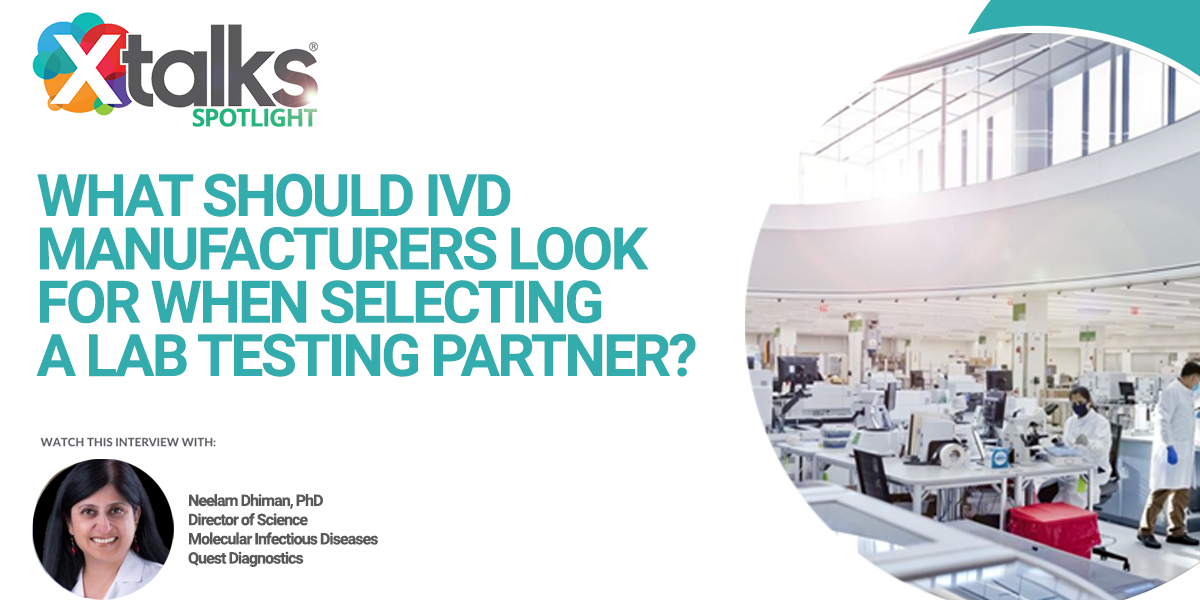Depending on the design and use of a medical device, manufacturers may be required to develop a biological safety evaluation before a device secures regulatory approval. While the main focus of this testing is to assess the biocompatibility of a medical device and the potential risk to the patient, it is imperative that device manufacturers avoid costly and unnecessary testing.
To gain a better understanding of the complexities of biological safety evaluations, and how medical device manufacturers can adapt to changing regulations, I spoke with Audrey Turley, B.S., RM (NCRM), CBA (ASQ), Research Scientist, Nelson Labs.
Audrey is a biocompatibility expert with two decades of research and laboratory experience in the medical device industry. For more insight into how medical device manufacturers can develop a comprehensive biological safety evaluation, watch Nelson Labs’ webinar.
What is a Biological Safety Evaluation and when is it used?
A biological safety evaluation is really a program that medical device manufacturers developed to address potential risks of the device to a patient. This is a different area of risk where it’s not based on the function or use of the device, but it’s based on the materials and manufacturing process for the device.
Medical device manufacturers develop this plan to address any risks that those materials used in the device will pose to the patient. So it’s used anytime a new device is invented or developed. A biological safety evaluation is also completed anytime a manufacturer makes a change to the device.
For example, if a current manufacturer decides that they want to sterilize their device differently, they’ll need to assess the potential risks associated with that change. This is also used whenever a company’s marketing department decides to change the colorants used in a medical device. If there is a change of location for manufacturing a device, or even just in the intended use of the device, they also have to do a biological safety evaluation to assess the impact to the patient.
Can you explain each of the three main steps involved in developing a Biological Safety Evaluation?
The first step is to really develop your plan and identify what your risks are, so we call this a biological evaluation plan. At this point we’re just identifying what risks are present based on the use of the device, including:
- Where it’s contacting the body – if it’s just applied on the skin versus if it comes in contact with circulating blood
- The length of use of the device
- Situational risks – sometimes these special devices are made up of novel materials or novel uses where the risk is really specialized. For example, maybe the device could affect reproductive health or development, especially if it’s used in pregnant women or pediatric populations.
We’re identifying all of those risks right up front and then we use the information on the type of device and where it’s used to outline a plan of testing and literature research review. This can be written in a document and taken to a regulatory agency for review to make sure it falls in line with all the guidelines that are appropriate for the specific device and specific country of market.
This leads us to the second part of a biological safety assessment, where we carry out the testing, and possibly do some further risk assessments. Sometimes in testing you get results you weren’t anticipating. For example, you could have a failure. Sometimes we actually expect a failure based on the materials, which gives us grounds to have a further conversation through a risk assessment, in order to decide if the risk is clinically relevant. If a risk is identified, we’ll also determine whether it’s a risk worth taking based on the patient population. Another option is to do further assessments to determine the toxicological risk of the medical device. The regulatory agencies are now allowing this more for long-term contacting devices, where we can do some alternate testing from what’s been allowed before.
The third and final step is to compile the biological evaluation report, and this is summarizing all previous efforts together into one document. We’ve had a lot more requests about this from the agencies because there really doesn’t seem to be a straightforward approach anymore for medical devices, and because the industry is trying to eliminate unnecessary testing. The regulators are asking clients to pull data from multiple sources and so when you do that, you really need to organize it all using a single platform.
The biological evaluation report is really about pulling all of that information together, to introduce the medical device, how it’s used, all of the test results, where potential problems were identified, and what was done to address those problem. This report is then analyzed and reviewed by an expert in the area of biological safety evaluation to determine if there’s still a potential hazard to the patient, or if all of those risks and hazards have been mitigated.
What’s the timeline for this type of process, from making the biological evaluation plan, performing the testing and written risk assessments, to generating a biological evaluation report?
It is incredibly varied, and there have been multiple times that we have been brought in to consult in the middle of a project, and sometimes even at the end to address a response from a regulatory agency. Some testing takes only a week and then a written document can take four to six weeks to be completed. In this case, you could be looking at less than two months to go through the entire process of developing a biological safety evaluation.
However, this is not always the case. Sometimes you’re looking at the bulk of a year for testing from developing this plan because it may require a special product to be made for the testing, depending on what testing is being requested. Carrying out that testing can take at least half a year, and then writing up that summary report can again take another five or six weeks just to pull all that information together. The process of developing a biological safety evaluation is just as varied as the devices that we look at.
What tests are available to assess the safety of a medical device, and what is the role of chemistry testing?
The tests that we talk about are all contained in the ISO 10993 series, and this consists of more than 19 sections that cover every bit of testing. What we’re addressing here are biological endpoints. When we think about the human body, we don’t have the capability to assess a device for all these different endpoints at once, so we assess each reactive concern separately.
First, we look at cytotoxicity, which assesses the safety of the device on the most basic cellular level. Then, we look for irritation and sensitization which informs us about possible allergic reactions. We can also look for more serious things like genotoxicity that would have the potential to cause tumor growth. We can also address specific body contact with testing like hemocompatibility which assesses the safety of devices in contact with blood.
There are also a number of other long-term tests that will determine the subacute, subchronic, chronic toxicity and carcinogenicity. What we’re looking for in these tests are systemic responses based on a time determination, and the chemistry testing is what we use for those tests.
These toxicity tests can last for several months, so what we can do as an alternative is to run some extractable and leachable chemistry testing where we’re looking for different types of compounds. In the ISO 10993 series, they have guidelines to follow to detect and assess the impact of compounds discovered during chemistry testing of a medical device. Compounds that need further assessment are sent to our board-certified toxicologists and they do a literature search on several online databases to find studies on those compounds to address the identified risk or specific biological endpoint.
This chemistry testing approach saves time, lab animals and is cheaper compared to long-term tests. It’s a complex picture to summarize, but the chemistry testing is definitely a valuable part of what we do.
What can people expect to learn from your webinar?
It really goes back to the big three steps: making your biological evaluation plan, carrying out your plan and then writing the report. We’ll likely focus a lot on the second part because that is the longest part of this process, and that is where everything can either come together or fall apart (i.e. performing incorrect tests or failures).
We’ll talk about how to address failures, when it’s a concern and what your options are. While it’s nice to look at the big picture, most people are not coming into this process at step one. Medical devices have been around for a really long time, and manufacturers are consistently dealing with changes to guidelines, different regulatory bodies and different markets.
In this webinar, I want to talk about why it doesn’t matter if you’re currently in the middle of this process, because we can pick you up wherever you are and get you going. We can help you identify what the agencies are asking for when they give you feedback in regards to your biological safety evaluation.
To learn more from Audrey Turley of Nelson Labs, register now for her webinar on, “Developing a Biological Safety Evaluation.”









Join or login to leave a comment
JOIN LOGIN